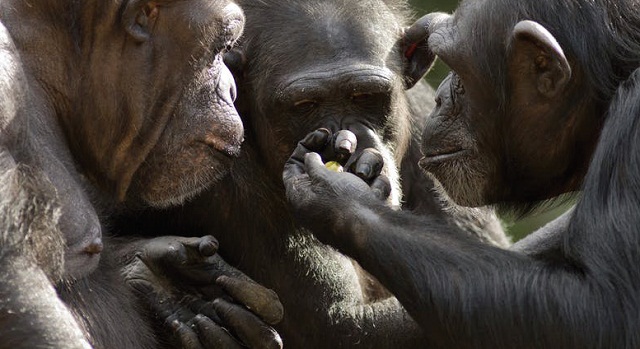
Study suggests they’ve got the voice but not the brains
Kampala, Uganda | JACOB DUNN | We all know that parrots can talk. Some people may have even seen elephants, seals, or whales mimicking speech sounds. So why can’t our closest primate relatives speak like us? Our new research suggests they have the right vocal anatomy but not the brainpower to use it.
Scientists have been interested in understanding this phenomenon for centuries. Some have argued that non-human primates didn’t have the right-shaped body parts to make the same sounds as we do, and that human speech evolved after our speech organs changed. But comparative studies have shown that the form and function of the larynx and vocal tract is very similar across most primates species, including humans.
This suggests that the primate vocal tract is “speech ready” but that most species don’t have the neural control to make the complex sounds that comprise human speech. When reviewing the evidence in 1871, Charles Darwin wrote “the brain has no doubt been far more important”.
Along with JeroenSmaers from Stony Brook University in New York, I have been investigating the relationship between the number of different calls that each primate species can make and the architecture of their brains. For example, Golden pottos have only ever been recorded using two different sounds, while chimpanzees and bonobos use around 40.
Our new study, published in Frontiers in Neuroscience, focused on two particular features of the brain. These were the cortical association areas that govern voluntary control over behaviour, and the brainstem nuclei that are involved in the neural control of muscles responsible for vocal production. Cortical association areas are found within the neocortex and are key to the higher order brain functions considered to be the foundation for the complex behaviour of primates.
The results indicate a positive correlation between the relative size of the cortical association areas and the size of the vocal repertoire of primates. In simple terms, primates with bigger cortical association areas tended to make more sounds. But, interestingly, a primate’s vocal repertoire was not linked to the overall size of its brain, just the relative size of these specific areas.
We also found that apes have particularly large cortical association areas, as well as a bigger hypoglossal nucleus than other primates. The hypoglossal nucleus is associated with the cranial nerve that controls the muscles of the tongue. This suggests that our closest primate relatives may have finer and more voluntary control over their tongues than other primate species.
By understanding the nature of the relationship between vocal complexity and brain architecture, we hope to identify some of the key elements that underlie the evolution of complex vocal communication in our ancestors, ultimately leading to speech.
Evolution of speech
The origins of speech is a topic that has long been debated. The Société de Linguistique de Paris famously banned any further enquiry into the matter in its publication pages in 1866, as it was deemed to be far too unscientific. But much progress has been made in the last few decades thanks to a wide range of evidence, such as that from studies of communication in other species, fossils and, more recently, genetics.
Research has shown that some primate species, such as vervet monkeys, use “words” to label things (what we would call semantics in human language). Some species even combine calls into simple “sentences” (what we would think of as syntax). This can tell us a lot about the early evolution of language, and the elements of language that might have already been present in our common ancestors with these species some millions of years ago.
 The Independent Uganda: You get the Truth we Pay the Price
The Independent Uganda: You get the Truth we Pay the Price



